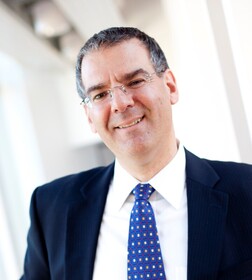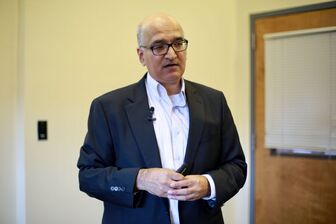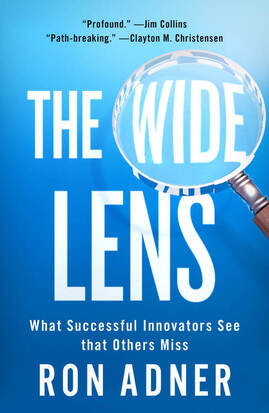 Ron Adner, Author of "The Wide Lens" and an award-winning professor of strategy at the Tuck School (Dartmouth) Ron Adner, Author of "The Wide Lens" and an award-winning professor of strategy at the Tuck School (Dartmouth) When you are innovating, you can do everything right and still fail. How is that possible? According to Ron Adner, he writes in his excellent book The Wide Lens that "your success depends not just on your ability to execute your own promises but also on whether a host of partners—some visible, some hidden—deliver on their promises too." Companies that innovate are adept at execution focus, such as gaining customer insights, building core competencies, and beating the competition. The pitfalls they run into are co-innovation risk and adoption risk. Co-innovation risk occurs when a company's innovation is dependent on the commercialization and affordability of other innovations. Adoption risk occurs when a company's innovation is dependent on partners' adoption of it so that end consumers can decide whether it satisfies their needs and their willingness to pay for it. After reading The Wide Lens, I had few questions for Ron Adner. I narrowed it to five questions whose answers are below: Five Questions Question 1: You point out how hard it is for companies to have innovation success. Do companies need to experiment with many innovations using the minimum viable ecosystem (MVE) approach to have a handful of successes? When companies innovate in ecosystems, their success depends on their ability to line up partners. The MVE is an approach to finding and organizing the starting coalition on the larger journey. Unlike an MVP approach, which is focused on discovery, and the MVE approach is focused on aligning – you need to have a good sense of where you are heading before approaching partners. If you don't, it will be hard to get them to commit at scale, and the risk is getting trapped in pilots. Question 2: Do you think China has changed the game when it comes to innovation? Is their approach different from the wide lens approach with the government playing an important role? Does their approach mitigate or even eliminate the co-innovation and adoption chain risks? Successful innovation in China, like everywhere else, depends critically on managing adoption chain risk and co-innovation risk. One difference in China is that the government can play a more active role in resolving these issues on both the regulatory and the incentive side. The Chinese approach is reminiscent of the role that Japan's Ministry of Industry and Trade (MITI) played in its rise through the 1970s and 80s. A second difference is one of context – China's rapid rise in prosperity interacts with what had been a challenged infrastructure to enable a fast path adoption. For example, where mobile payments in the West have to outcompete credit cards, in China the competition is cash in the absence of wide-spread credit cards. And when you combine that with the government wanting more traceable transactions, you can see why mobile payments would take off as quickly and penetrate as deeply as they have. These two differences in the Chinese approach are not a substitute for innovation, they allows innovations to scale and succeed faster. Question 3: Is innovation so complex today that only large companies like Apple, Amazon, Google, etc. can adopt the wide lens when it comes to innovation? If anything, innovation's complexity means that it is even MORE important for smaller firms to master the Wide Lens principles. The giants have the time and resources to take multiple shots on goal. We see them failing in many of their ecosystem ambitions (payments, health, mobility, all around, with shout-outs to Google showing how not to launch a game platform with Stadia, and Apple losing in the education market that gave them their start). There is plenty of room for innovation, and even ways to outcompete the giants, as long as you know how to change the game (this is the subject of my new book, Winning the Right Game, which will come out next year). Question 4: Do you think innovation success will ever be achieved by one company the way AT&T Bell Labs did by creating universal connectivity? Do you feel that companies will have to continue to overcome all three risks: Execution, Co-innovation, and Adoption Chain? Even the rise of the Bell network was the product of decades of ecosystem construction. Bell Labs was founded in 1876, so looking at Bell Labs in the 1970s is looking at the cutting-edge R&D lab of a long-established monopolist. Keep in mind too that Bell/AT&T did not capture the benefit of the vast majority of its inventions. Other innovators figured out not just execution at scale but also how to align the adoption chain and co-innovators that brought the inventions into mainstream reality… Everyone has to, or had to, deal with the Wide Lens issues. Question 5: As of this writing, Tesla's market capitalization is higher than GM and Ford combined. Can you briefly explain what made Tesla succeed in electric vehicle (EV) when Better Place could not? Market cap is variable, but the accomplishment is absolute. Telsa has succeeded in changing the game in EVs and – more impressively – in the automobile industry writ large. Better Place imploded because of an own-goal on execution and a clash of egos. There is a nice epilogue on their story posted at ronadner.com. Tesla's biggest disruption in my view is less EV per se (though that is huge) than the integration of software into so many parts of the car and the car network, which allows them to do unique things with upgrades, recalls, charging networks, acquiring autonomous driving data, etc. – an incredible achievement. In addition to Musk's innovative and strategic brilliance, he deserves credit for his ability to manage the finance side, bringing money forth from almost thin air. Bezos did this in the early days of Amazon, and that gave him the freedom to operate that he has used since. With Better Place, which had a strategy and model that I still think is superlative, the oxygen of capital simply ran out, and founder/CEO Agassi could not bring in the next critical tranche. It is a very disappointing end to what was a promising innovation. Bonus Question: Do you think Wall Street is more patient with charismatic CEOs like Jobs, Bezos, and Musk when they start making money with their innovation? Is charismatic leadership today a necessity for innovation success? Neither sufficient nor necessary, but it never hurts. : ) I want to thank Ron Adner for taking time out of his busy schedule to answer few questions I had about his book The Wide Lens. To learn more about Ron Adner: Book: The Wide Lens Web site at Dartmouth: Professor at Dartmouth Speeches: An Interview with Ron Adner re: The Wide Lens #####  I am an author, speaker, executive coach. I guide people thrive on high stakes stage whether it's for a job interview, career advancement, a sales presentation or a high-stakes speech. I am the author of a practical book on speaking titled Winning Speech Moments: How to Achieve Your Objective with Anyone, Anytime, Anywhere. The main idea of the book is that if you want people to remember your speech and take action, you must create a winning speech moment. Please download the free speech checklist I created that I always use to create a winning speech for any occasion. Please contact me if you would like to discuss how you can work with me. If you are interested in inviting me to give a Zoom talk (during the pandemic) on job Interviewing. career development or high-stakes speaking, you can reach me at [email protected] or 732-847-9877. Note, if you are an author, content producer or interesting and would like me to interview with five questions and then publish it as a blog post and promote it on LinkedIn, Twitter and Facebook, please contact me.
0 Comments
Leave a Reply. |
AuthorJay Oza Archives
July 2024
Categories
All
|
© 2017 Winning Speech Moments


 RSS Feed
RSS Feed